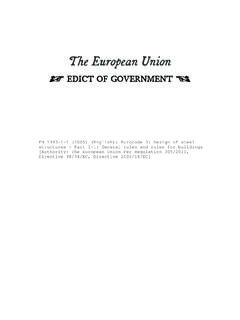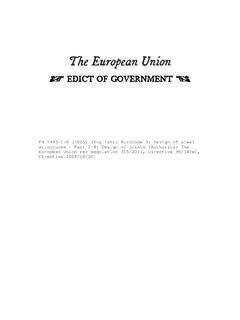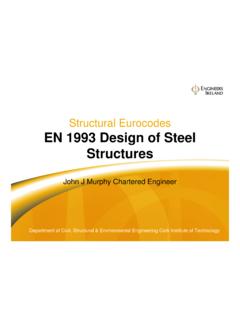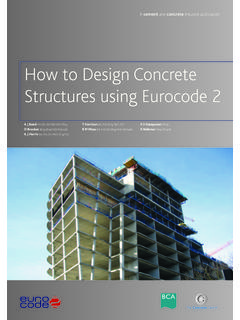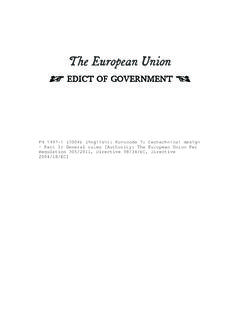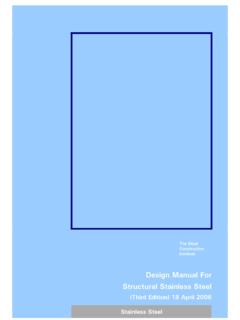Transcription of 12Innovative rules in Eurocode 3, Part 1-10
1 NSCC2009 1 INTRODUCTION In the frame of the unification of the European technical rules for the design of steel structures ( Eurocode 3) a method has been developed to select steels to avoid brittle fracture. This concept is implemented in EN 1993-1-10:2005 and applicable to structural steel members subject to fatigue loads ( bridges) with details covered by EN 1993-1-9:2005. It is based on a safety assessment using fracture mechanics and assumes surface cracks with design sizes which may have developed from initial flaws which were not found by non-destructive testing (NDT) and propagated under fatigue load. In assessment the K-concept is applied using stress intensity factors. The subject of this paper are recent practical engineering applications of these rules in different fields of applicability.
2 In fact the rules are developed with a main focus on bridge structures. Therefore some of the basic assumptions of the standard simplified procedure using tabulated values are not transferable to other fatigue loaded steel structures than bridges. However using the basic design formula and using sufficiently chosen assumptions also other structures can be designed. The paper starts with a summary of the background of the design rules . Thereafter an example shows a standard application using the simplified procedure. The paper ends with other examples of application using the basic design formula. ABSTRACT: The new European unified technical design rules for steel structures ( Eurocode 3) offer a method in EN 1993-1-10 to select steels to avoid brittle fracture.
3 This concept, based on a safety assessment using fracture mechanics, is available for members subject to fa-tigue loads ( bridges). This paper present the wide range of applicability of these rules . Innovative rules in Eurocode 3, part 1-10 for the choice of material toughness and the wide range of applicability B. K hn1 & G. Sedlacek2 1 Verheyen-Ingenieure GmbH & Co. KG, Bad Kreuznach, Germany 2c/o Institute of steel Construction, RWTH University, Aachen, Germany 25 2 BACKGROUND OF THE rules Fracture-behavior of steel under low temperature For ferritic steels, the fracture behavior of tensile loaded components, in particular the extent, to which they exhibit a non-linear load-deformation curve by yielding, depends strongly on the temperature.
4 Figure 1 shows in a schematic way the fracture behavior of tensile loaded components which bear a crack-like flaw. The figure contains different information which are related to the fracture behavior. Characteristic temperatures are also defined which enable the distinction of fracture behavior into brittle and ductile: 1. The fracture mechanism (on a microscopic scale) being cleavage at low temperatures and becoming shear or ductile above a temperature Ti. 2. The fracture stress depending on temperature and increasing from low temperatures to a temperature Tgy, where net section yielding is observed before fracture and going further up to a temperature Tm where the full plastic behavior in the gross section and the ultimate load is reached.
5 3. The macroscopic description of the fracture behavior is defined as brittle if fracture occurs before net section yielding and where the global behavior is linear elastic or as ductile behind this point, where plasticity can be observed in the cross section and the load displacement deviates from linearity. The temperature region above Tm characterises the region with large plastic strains which enable plastic redistribution of stress concentrations in the cross-section and the formation of plastic hinges for plastic mechanisms. In the upper shelf region above Ta the ultimate tension strength results from the stability criterion and is not controlled by toughness. In the range T 7 Tm (room temperature) all member tests have been carried out, from which the resistance functions and design rules for steel structures in Eurocode 3 have been derived.
6 Below Tm is the temperature transition range that leads to the lower shelf behavior, where the material toughness decreases with temperature and the fail-ure modes change from ductile to brittle. Below Tm the macroscopic plastic deformations are smaller than those above Tm. They suffice to reduce stress concentrations in the cross-sections so that the nominal stress concept can be applied. They are, however, no longer sufficient for plastic hinge rota-tions, so that global analysis should be made on an elastic basis. Figure 1. Fracture behavior of components depending on temperature (schematic view). A limit that separates this macroscopic ductile failure mode from the brittle failure mode is the tem-perature Tgy, at which net section yielding is reached before failure.
7 The brittle fracture avoidance concept presented here is related to this area. Below Tgy the plastic deformations are restricted to local crack tip zones, which can be quantified with fracture mechanics parameters like K, CTOD or J-Integral. Fracture mechanics method in background of the design rules Fracture assessments in the brittle area below the temperature Ti below which no stable crack growth may occur could be performed with fracture mechanical parameters as J-integrals or CTOD-values that take both the elastic and the plastic strains into account. However for practical reasons, the stress intensity functions, initially valid for the fully elastic range T < TIc only, can be used in a more practical way because of their availability from handbooks 26 where solutions can be found for most relevant cases.
8 The stress intensity factor K is taken for mode I actions and has been derived from a stress field around the crack tip. Its validity is limited to elastic behavior where plasticity even in the vicinity of the crack tip is limited. The error resulting from neglecting the local plasticity at the crack tip is considered by a correction factor kR6 from the CEB6-R6-Failure Assessment Diagram (FAD) (Harrison et al. 1986) applied to the elastic value of the action effect Kappl,d. The corresponding resistance is KMat,d depending on temperature TEd, which may be determined from J-Integral, CTOD or valid KIc-values from CT-tests. The basic verification format with these values reads: Ed (K) > Rd (K) or Kappl,d > KMat,d (1) which, however, needs further processing to achieve two goals: 1.
9 Correlation between the resistance KIc raised from CT-tests and the standard values TKV raised from Charpy-V-tests, 2. Transformation to a format for verifying with temperatures on the action side TEd and as well as on the resistance side TRd (based on TKV). The first goal is reached in two steps. First by expressing KMat,d as a function of TEd by the standardized K-(TK100 - TEd)-Master curve from Wallin (Wallin 1994), which refers to the temperature TK100, for which KMat takes the value 100 MPa. Second by correlating the temperature TK100 for the fracture mechanical parameter K = 100 MPa(m) with the temperature T27J for the Charpy-impact energy KV = 27J (modified Sanz-correlation (Marandat et , Sanz 1980)).
10 The verification formula based on K-values may be transferred to a formula based on temperature values T by applying logarithms, so that the final assessment scheme reads, see also Figure 2: Figure 2. Safety assessment for limit state brittle fracture in EN 1993-1-10 ()EddMatdapplT K K,*, ()EddMatRdappldapplT K kKK,6,*, = 411006,*,251052exp7020 + + + =effREdRdappldapplbTTT kKK 41276,*,25105218exp7020 + + + + =effRJEdRdappldapplbTCTT kKK T100100T in CK inMPa mSanz-T100-T27J-CorrelationT27J27T in CAV in JT27J in CT100in CT100 = T27J - 18 C = 13 CT100100 TEd in CKMat inMPa mWallin-Toughness-Curve11 LRkR6R6-FADW allin-Master-KurveModifizierte Sanz-T100-T27J-KorrelationKV in J()ReffdapplEdJTb KTCT + + 70102520ln52 1825,0*,2727 For more information about the background of the design rules , see (K hn 2005, Strangh ner 2006, Sedlacek et al.)
